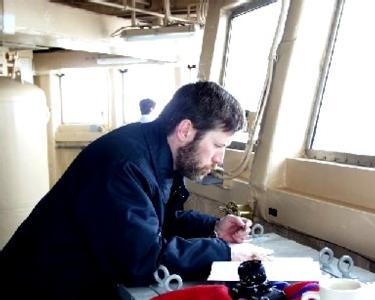
|
28 April, 2000Beginning With Growlers DRAFT April 28, 2000 Daily Data (20:30): Lat. 6817.094 N Long. 06112.138 W Heading 275.982 Air Temp. -11.04 C 12.15 F True Wind Dir. 291.0 True Wind Speed 16.4 Dear Everyone, To experience peace and tranquility surrounded by stunning beauty, I go to the bridge. In deference to the work at hand, the bridge is maintained as a quiet area. Guest voices are soft and conversations are comfortable. Surrounded by large windows on all sides, individuals serenely view the sky, water, leads, ice floes, and calved ice. The magnificence is calming. I just came from the bridge having had a conversation with Robert Wolfe, Research & Development Officer, Marine Transport Canada about the calved ice we were admiring. Robert used a sextant to measure the angles of this ice and then calculated its size to determine its classification. Vocabulary of the day: >From MANICE; Manual of standard Procedures for Observing and Reporting Ice Conditions, Canadian Ice Service, April 1994. Growler: Smaller piece of glacier ice than a bergy bit, often transparent, but appearing green or almost black in color, extending less than 1m. above the sea surface. Growlers have a length of less than 5m. and normally occupy an area of about 20sq. m squared. Bergy Bit: A piece of glacier ice, generally showing 1 to less than 5m. above sea level, with a length of 5 to less than 15m. They normally have an area of 100-300 sq. m. Small Iceberg: A piece of glacier ice extending 5 to 15m. above sea level and with a length of 15 to 60m. Medium Iceberg: A piece of glacier ice extending 16 to 45m. above sea level and with a length of 61 to 120m. Large Iceberg: A piece of glacier ice extending 46 to 75m. above sea level and with a length of 121 to 200m. Very Large Iceberg: A piece of glacier ice extending more than 75m. above sea level and with a length of more than 200m. Ice Island: A large piece of floating ice protruding about 5m. above sea-level, which has broken away from an Arctic ice shelf. They have a thickness of 30-50m. and an area of from a few thousand square meters to 500 sq. km. or more. They are usually characterized by a regularly undulating surface giving a ribbed appearance from the air. Ice Island Fragment: Piece of an ice island that has broken away from the main mass. Robert Wolfe explained that the sizes of calved ice in the Arctic would normally range from Growlers to Very Large Icebergs. To determine the size of calved ice, take a radar range to determine the distance. Then using a sextant, calculate the height and width. By assuming a right angle triangle, determine the size in meters. The Coast Guard personnel on duty supplied us with a radar range of 1’.6 nautical miles. The measurements that Robert took using the sextant of the calved ice we were observing are width = 11°17' and height = 0 ° 29 '. What is the size of this iceberg in meters? (The answer is below, but don't cheat! Go ahead and give it a try.) This evening we are 207.1 miles from Home Bay and hope to arrive sometime on Sunday to begin ice testing. The Healy just now came to a stop. I looked out my porthole and see snow covered ice spanning to the horizon. We have begun backing to throw forward into the ice floe. We are not at full power today and have encountered ice averaging from 3 to 4 feet in thickness. I have great admiration for the technology of the Healy, my home for these 3 ½ weeks, and the skills and dedication of its crew and the scientists aboard during this testing phase. Best regards, Sandra PS: Do you need the answer? Congratulations for giving it a try! Answer: 584 meters width and 25 meters height. For photos and more: ../tea_kolbfrontpage.html For further information: ../ http://www.uscg.mil./pacarea/healy
Contact the TEA in the field at . If you cannot connect through your browser, copy the TEA's e-mail address in the "To:" line of your favorite e-mail package. |





